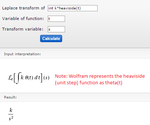dpkdpk
Newbie level 3
Hi everyone, I've been stuck on this one. Here's an excerpt from my reference source:
--------------------------
The input voltage Vo to the VCO controls its output frequency, which can be expressed as:

where omega_0 is the center angular frequency of the VCO, k1 is the gain of the VCO, and u(t) is a unit step function, which is defined as:

The phase angle of the VCO can be obtained by integrating Equation (1) as:

---------------------------
My problem is that I don't understand getting from equation 3 to equation 4. Ignoring the constant k1, the integral of a unit step function u(t) is a ramp function t*u(t). The Laplace transform of t*u(t) is 1/s^2. Just to confirm, I typed this equation into the Wolfram Laplace Transform Calculator:

Another way to approach this problem is using the relationship:

Setting k1 aside, g(t) is the unit step function u(t). The Laplace Transform [G(s)] of a unit step function is 1/s. So then G(s)/s = (1/s)/s = 1/s^2.
Everywhere else confirms that the transfer function in the s-domain of a VCO is k1*1/s, and the rationale is that 1/s is the Laplace transformation of an integration. However, I wish I could have a derivation that makes sense.
I hope you guys can help me out. Thanks!
--------------------------
The input voltage Vo to the VCO controls its output frequency, which can be expressed as:
where omega_0 is the center angular frequency of the VCO, k1 is the gain of the VCO, and u(t) is a unit step function, which is defined as:
The phase angle of the VCO can be obtained by integrating Equation (1) as:

---------------------------
My problem is that I don't understand getting from equation 3 to equation 4. Ignoring the constant k1, the integral of a unit step function u(t) is a ramp function t*u(t). The Laplace transform of t*u(t) is 1/s^2. Just to confirm, I typed this equation into the Wolfram Laplace Transform Calculator:

Another way to approach this problem is using the relationship:
Setting k1 aside, g(t) is the unit step function u(t). The Laplace Transform [G(s)] of a unit step function is 1/s. So then G(s)/s = (1/s)/s = 1/s^2.
Everywhere else confirms that the transfer function in the s-domain of a VCO is k1*1/s, and the rationale is that 1/s is the Laplace transformation of an integration. However, I wish I could have a derivation that makes sense.
I hope you guys can help me out. Thanks!